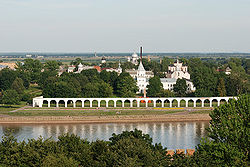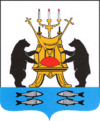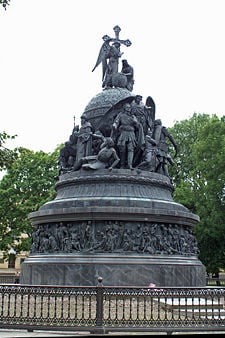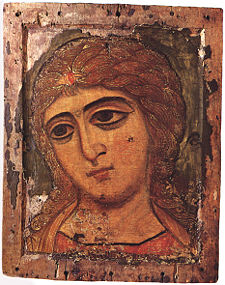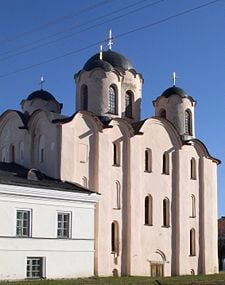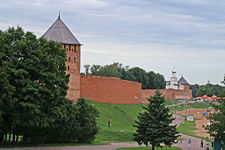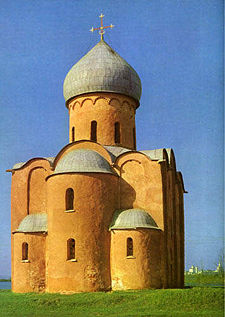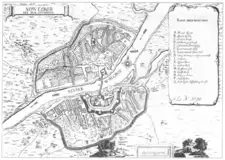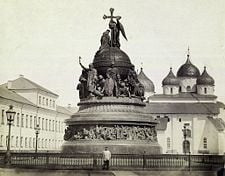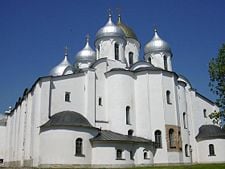Difference between revisions of "Veliky Novgorod" - New World Encyclopedia
Rosie Tanabe (talk | contribs) |
|||
| (23 intermediate revisions by 7 users not shown) | |||
| Line 1: | Line 1: | ||
| − | {{ | + | {{Copyedited}}{{Approved}}{{Submitted}}{{Images OK}}{{Paid}} |
| + | {{Infobox Settlement | ||
| + | |official_name = Veliky Novgorod | ||
| + | |other_name = | ||
| + | |native_name = Великий Новгород | ||
| + | |image_skyline=Yaroslavovo Dvorische 01.jpg | ||
| + | |image_caption=View of the [[Yaroslav's Court]] | ||
| + | |latd=58 | ||
| + | |latm=33 | ||
| + | |lats= | ||
| + | |longd=31 | ||
| + | |longm=17 | ||
| + | |longs= | ||
| + | |map_label_position=right | ||
| + | ||image_shield = Coat of Arms of Veliky Novgorod.png | ||
| + | |seal_size = | ||
| + | |image_coa= | ||
| + | |coa_caption= | ||
| + | |image_flag=Flag of Veliky Novgorod.png | ||
| + | |flag_caption= | ||
| + | |anthem= | ||
| + | |anthem_ref= | ||
| + | |holiday= | ||
| + | |holiday_ref= | ||
| + | |federal_subject=[[Novgorod Oblast]] | ||
| + | |federal_subject_ref=<ref name="Ref119" /> | ||
| + | |adm_data_as_of=December 2011 | ||
| + | |adm_city_jur=[[city of federal subject significance|city of oblast significance]] of Veliky Novgorod | ||
| + | |adm_city_jur_ref=<ref name="Ref119" /> | ||
| + | |adm_ctr_of=[[Novgorod Oblast]], city of oblast significance of Veliky Novgorod | ||
| + | |adm_ctr_of_ref=<ref name="Ref119" /> | ||
| + | |inhabloc_cat=City | ||
| + | |inhabloc_cat_ref=<ref name="Ref119" /> | ||
| + | |inhabloc_type= | ||
| + | |inhabloc_type_ref= | ||
| + | |mun_data_as_of=September 2010 | ||
| + | |urban_okrug_jur=Veliky Novgorod Urban Okrug | ||
| + | |urban_okrug_jur_ref=<ref name="Ref832" /> | ||
| + | |mun_admctr_of=Veliky Novgorod Urban Okrug | ||
| + | |mun_admctr_of_ref=<ref name="Ref832" /> | ||
| + | |leader_title=Mayor | ||
| + | |leader_title_ref= | ||
| + | |leader_name=Yury Bobryshev | ||
| + | |leader_name_ref= | ||
| + | |representative_body=City Duma | ||
| + | |representative_body_ref= | ||
| + | |area_of_what= | ||
| + | |area_as_of= | ||
| + | |area_footnotes = | ||
| + | |area_total_km2 = 90.08 | ||
| + | |area_km2=90.08 | ||
| + | |area_km2_ref= | ||
| + | |population_footnotes = <ref name="2010Census" >[http://www.perepis-2010.ru/results_of_the_census/results-inform.php Preliminary results of the 2010 All-Russian Population Census] (in Russian) Retrieved February 9, 2012.</ref> | ||
| + | |population_note = | ||
| + | |population_total = 218724 | ||
| + | |population_density_km2 = | ||
| + | |population_density_sq_mi = | ||
| + | |population_as_of = 2010 census | ||
| + | |pop_2010census=218724 | ||
| + | |pop_2010census_rank=85th | ||
| + | |pop_2010census_ref=<ref name="2010Census" /> | ||
| + | |pop_2002census=216856 | ||
| + | |pop_2002census_rank=86th | ||
| + | |pop_2002census_ref=<ref name="PopCensus">{{ru-pop-ref|2002Census}}</ref> | ||
| + | |pop_density= | ||
| + | |pop_density_as_of= | ||
| + | |pop_density_ref= | ||
| + | |pop_latest= | ||
| + | |pop_latest_date= | ||
| + | |pop_latest_ref= | ||
| + | |established_date=862 | ||
| + | |established_title=First mentioned | ||
| + | |established_date_ref=<ref name="tikhomirov"/> | ||
| + | |current_cat_date= | ||
| + | |current_cat_date_ref= | ||
| + | |prev_name1=Novgorod | ||
| + | |prev_name1_date=1999 | ||
| + | |prev_name1_ref= | ||
| + | |prev_name2= | ||
| + | |prev_name2_date= | ||
| + | |prev_name2_ref= | ||
| + | |postal_codes=173xxx | ||
| + | |postal_codes_ref= | ||
| + | |dialing_codes=8162 | ||
| + | |dialing_codes_ref= | ||
| + | |website=[http://www.adm.nov.ru/ www.adm.nov.ru] | ||
| + | |website_ref= | ||
| + | |commoscat= | ||
| + | |date=May 2010 | ||
| + | }} | ||
| + | '''Veliky Novgorod''', the third largest city in [[Russia]] and the administrative center of Novgorod Oblast, has deep historical roots to [[Russia]]n [[culture]] as a whole. The oldest city of Russia, it is known as the cradle of Russian [[democracy]]—its citizens were full participants in representative rule as early as the twelfth century. The city was a medieval center of trades and crafts and is considered a boundless field for research by historians, architects and [[archeology|archaeologists]]. Though the city's historical and cultural landmarks were systematically destroyed during [[World War II]], it is still famed for the incredible [[architecture]] that remains. | ||
| + | {{toc}} | ||
| + | The preeminence of Veliky Novgorod in Russian culture is represented by the root of the name, where "Novgorod" is the Russian word for "new city," and "Veliky" means "the Great." | ||
{{Infobox World Heritage Site | {{Infobox World Heritage Site | ||
| − | | WHS | + | | WHS = Historic Monuments of Novgorod and Surroundings |
| − | | Image | + | | Image = [[Image:Natalya dulchenko kokui.jpg|250px|The medieval walls of Novgorod (pictured) withstood many sieges]] |
| State Party = [[Image:Flag of Russia.svg|22px]] [[Russian Federation]] | | State Party = [[Image:Flag of Russia.svg|22px]] [[Russian Federation]] | ||
| − | | Type | + | | Type = Cultural |
| − | | Criteria | + | | Criteria = ii, iv, vi |
| − | | ID | + | | ID = 604 |
| − | | Region | + | | Region = [[List of World Heritage Sites in Europe|European Russia]] |
| − | | Year | + | | Year = 1992 |
| − | | Session | + | | Session = 16th |
| − | | Link | + | | Link = http://whc.unesco.org/en/list/604 |
}} | }} | ||
| − | |||
| − | |||
| − | |||
==Geography== | ==Geography== | ||
| − | Ancient Novgorod rose to a political force partially due to its ideal location with easy access to both the Oka and the Volga | + | Ancient Novgorod rose to a political force partially due to its ideal location with easy access to both the [[Oka River|Oka]] and the [[Volga River]]s. It is located in the northwest region of [[Russia]], an area commonly referred to as Russia's heartland. The title of the area reflects the high [[agriculture|agricultural]] productivity of the region, as well as the overall economic importance of the area to Russia as a whole. |
| − | + | Novgorod is situated between the major metropolises [[Moscow]] and [[Saint Petersburg]], and is rising to become a population center in its own right. Recent estimates put the population at 216,856, which while lower than the measurements in Soviet Times, still represents a large city by Russian standards. | |
==Economy== | ==Economy== | ||
| − | Education is an incredibly important part of the Novgorod culture, as it was one of the first cities in Russian history to build a schoolhouse large enough to hold three hundred students at once. The high levels of education in Novgorod directly spawned many of the key industries for the city, particularly the book making and printing industries. Novgorod also expressed its intellectual history through art, becoming a major center for icon painting and applied decorative arts. | + | [[Education]] is an incredibly important part of the Novgorod culture, as it was one of the first cities in Russian history to build a schoolhouse large enough to hold three hundred students at once. The high levels of [[education]] in Novgorod directly spawned many of the key industries for the city, particularly the [[book-making]] and [[printing industries]]. Novgorod also expressed its intellectual history through [[art]], becoming a major center for [[icon]] painting and applied decorative arts. |
| − | Currently, much of the Novgorod economy is funded through foreign investment sources. Novgorod is widely considered to be one of the most | + | Currently, much of the Novgorod economy is funded through foreign investment sources. Novgorod is widely considered to be one of the most economically open Russian cities, a fact corroborated by [[tax]] breaks offered to foreign investors by the local government. Foreign investors tend to focus on heavy [[industry]], particularly the radio-electronic, furniture, and chemical fields. The high levels of investment have had some effect on the local population, raising the living standard above many other urban centers in Russia. In particular, Novgorod has a smaller homeless population than [[Moscow]] or [[St. Petersburg]]. |
==History== | ==History== | ||
| − | + | [[Image:Nowgorod 2005 Millenium Monument.jpg|thumb|225px|Bronze monument to the [[Millennium of Russia]] (1862).]] | |
| − | + | [[Image:goldenlocks.jpg|thumb|225px|Twelfth century Novgorod icon called ''Angel with Golden Locks''.]] | |
| − | + | [[Image:St. Nicholas Cathedral, Novgorod.JPG|thumb|225px|St Nicholas Cathedral, built by Mstislav I near his palace at Yaroslav's Court, Novgorod, contains twelfth-century [[fresco]]es depicting his illustrious family.]] | |
| − | + | [[Image:Nowgorod 2005 w.jpg|thumb|225px|Walls of the Novgorod Kremlin]] | |
| + | [[Image:Nereditsa.jpg|225px|thumb|Nereditsa church formerly contained the finest twelfth-century frescoes in Russia. The frescoes were destroyed when the church was blown up by the Germans in 1944.]] | ||
| + | [[Image:Novgorod 1701-1745.png|225px|thumb|City plan of Novgorod in the first half of the eighteenth century.]] | ||
| + | [[Image:Novgorod Monument LOC 06268u.jpg|thumb|225px|The ''Millennium of Russia'' (1862), with [[Saint Sophia Cathedral in Novgorod|Saint Sophia Cathedral]] in the background. The upper row of figures is cast in the round and the lower one is in relief.]] | ||
| + | [[Image:Cathedral of St. Sophia, the Holy Wisdom of God in Novgorod, Russia.jpg|thumb|225px|[[Saint Sophia Cathedral in Novgorod]], mid-eleventh century.]] | ||
| + | Novgorod was among the first cities to be formed in ancient Russia. Due to its proximity to the rivers, a small [[civilization]] sprouted that connected the [[Greece|Greek]] markets to the Russian and [[Baltic]] markets. [[Archaeology|Archaeological]] evidence regarding the trade dates the city to the tenth century C.E., when [[Christianity]] first made its way into Russia.<ref> V. L. (Valentin Lavrent’evich) Ianin and M. Kh. (Mark Khaimovich) Aleshkovskii, “Proskhozhdenie Novgoroda: (k postanovke problemy),” ''Istoriia SSSR'' 2, 1971, 32-61.</ref> Along with the ideas of Christianity, religious evangelists brought trade items to be traded in urban centers to fund their travels. While some records mention Novgorod as an urban center prior to the tenth century, it must be assumed that earlier accounts exaggerate the importance of the settlement, due to the lack of archaeological evidence to support a large city at an earlier time. | ||
===Princely state within Kievan Rus'=== | ===Princely state within Kievan Rus'=== | ||
| − | + | In 882, due to its growing economic and political authority, [[Oleg of Novgorod]] captured [[Kiev]] and founded the state of [[Kievan Rus]]. The city soon became the second most powerful city in Kievan Rus. It was ruled by a series of political organizations, called posadnicks, which governed when the ruler had no son to inherit the throne. When not being ruled by posadnicks, Novgorod had the good fortune to experience a series of benevolent rulers who governed with the best interest of the city's inhabitants in mind. | |
| − | In 882, | ||
| − | + | In [[Norse saga]]s the city is mentioned as the capital of [[Gardariki]] (i.e., the East Slavic lands). Four [[Viking]] kings—[[Olaf I of Norway]], [[Olaf II of Norway]], [[Magnus I of Norway]], and [[Harald III of Norway|Harald Haardraade]]—sought refuge in Novgorod from enemies at home. No more than a few decades after the death and subsequent [[canonization]] of Olaf II of Norway, in 1028, the city's community had erected a [[church]] in his memory, [[Saint Olaf's Church in Novgorod]]. | |
| − | + | After the tenth century, Novgorod emerged as a strong political and religious center. Its secure position was primarily due to Novogorod's strong military onslaught against [[Constantinople]]. As a result of the military campaign, Novgorod maintained equal trading rights with Byzantine and began a cultural interchange. East Slavic tribes from [[Byzantine]] began pouring into the ancient Slavic state, influencing the [[art]] and [[culture]] of Novgorod. | |
| − | |||
| − | + | The most notable among the benevolent leaders of Novgorod was [[Yaroslav I the Wise]], who had sat as prince while his father, [[Vladimir I of Kiev|Vladimir the Great]], was prince in Kiev. Yaroslav promulgated the first written code of laws (later incorporated into [[Russkaya Pravda]]) among the Eastern Slavs and is said to have granted the city a number of freedoms or privileges, which they often referred to in later centuries as precedents in their relations with other princes. His son, [[Vladimir of Novgorod|Vladimir]], sponsored construction of the great [[Saint Sophia Cathedral in Novgorod|St Sophia Cathedral]], more accurately translated as The Cathedral of Holy Wisdom, which remains in modern times. | |
| − | + | ===His Majesty Lord Novgorod the Great=== | |
| − | + | Under a series of benevolent rulers, the inhabitants of Novgorod were steadily granted increased independence and political autonomy. As a result of their increased role in the political process, it soon became apparent to the inhabitants of Novgorod that a singular ruling authority was not necessary for Novgorod to function. As a result of this revelation, the Novgorodians dismissed their prince in 1136. | |
| − | |||
| − | + | This date is seen as the traditional beginning of the Novgorod Republic, which invited and dismissed a series of princes over the next two centuries in order to rule Novgorod. While the veche, or electing authority, maintained supreme nominal power, some powerful leaders were able to assert a strong agenda over the objections of the people.<ref> Michael C. Paul, “The Iaroslavichi and the Novgorodian Veche 1230-1270: A Case Study on Princely Relations with the Veche,” ''Russian History/ Histoire Russe'' 31, No. 1-2, Spring-Summer 2004, 39-59.</ref> | |
| − | + | The [[city state]] controlled most of Europe's northeast, from today's [[Estonia]] to the [[Ural Mountains]], making it one of the largest states in medieval Europe, although much of the territory north and east of Lakes [[Lake Ladoga|Lagoda]] and [[Lake Onega|Onega]] were sparsely populated and never organized politically. While a basic outline of the various officials and the veche can be drawn up, the city-state's exact political constitution remains uncertain. The boyars and the archbishop ruled the city collectively, although where one officials power ended and another's began is uncertain. The prince, although reduced in power beginning in about the mid-twelfth century, was represented by his namestnik or lieutenant, and still played important roles as a military commander, legislator, and jurist. The exact composition of the veche, too, is uncertain, with some scholars such as Vasily Kliuchevksii claiming it was democratic in nature, while later scholars, such as Valentin Ianin and Alesandr Khoroshev, see it as a "sham democracy" controlled by the ruling elite. | |
| − | Novgorod | + | Novgorod, with its unique political structure, soon became a thriving center for arts and culture. During the [[Medieval Ages]] Novgorod gained its reputation for literacy and education, a reputation that stayed with the city for most of its legacy. |
| − | + | Written records at this time are in the form of birch bark documents, many of which were written in the archbishop's scriptorium. It was in Novgorod that the [[Novgorod Codex|oldest Slavic book]] written north of Macedonia and the [[Birch bark letter no. 292|oldest inscription in a Finnic language]] were unearthed. Possibly due to the intellectual and cultural strength of Novgorod, Novgorod did not fall during the Mongol invasion of ancient Russia. During this invasion, many surrounding cities fell to the [[Mongol]] invaders, but the cultural beacon of Novgorod resisted the invasion. | |
| − | |||
| − | |||
| − | + | ===Within the united Russian state=== | |
| + | Despite being able to resist the Mongol invaders, Novgorod began to falter politically in the early fifteenth century. Many scholars trace Novgorod's crumbling political power to an inability to provide the basic needs for its inhabitants. The citizens of Novgorod were particularly threatened by a lack of [[grain]], which drove many citizens close to starvation. In order to rectify the lack of bread Novgorod made a political agreement with [[Moscow]] and [[Tver]] to provide much needed grain. These cities used the agreement to exercise political control over Novgorod, and the city's independence began to weaken in proportionate to its dependence on Moscow and Tver for grain. Novgorod was eventually annexed by Moscow in 1478. | ||
| − | + | Eventually [[Ivan III of Russia|Ivan III]] annexed the city to [[Muscovy]] in 1478. Novgorod remained the third largest Russian city, however, until the famine of 1560s and [[Ivan IV of Russia|Ivan the Terrible]] sacking the city and slaughtering thousands of its inhabitants in 1570. The city's merchant elite and nobility were deported to Moscow, [[Yaroslavl]], and elsewhere. | |
| − | + | The difficulties for Novgorod continued in the Time of Trouble, when the city fell to [[Swedish]] troops. According to some accounts, the city voluntarily submitted to Swedish rule. Novgorod continued under Swedish authority for six years, after which time it was returned to Russia and allowed to rebuild a level of political authority. After the transfer of Novgorod to Russia, the city began an ambitious program of building and many of its most famous structures were constructed during this time period. Notable examples of this period of architecture include the Cathedral of the Sign and Vyazhischi [[Monastery]]. The most famous of Russian patriarchs, [[Patriarch Nikon|Nikon]], occupied the metropolitan see of Novgorod between 1648 and 1652. | |
| − | + | Novgorod became the administrative center of the Novgorod Governorate in 1727, demonstrating its reclaimed importance to Russia. This administrative division existed until 1927. Between 1927 and 1944 the city was a part of [[Leningrad Oblast]], and then became an administrative center of the newly formed [[Novgorod Oblast]]. | |
| − | |||
| − | [[ | ||
| − | |||
| − | + | Novgorod continued to be important to Russia until [[World War II]], when [[German]] troops occupied the city and systematically destroyed many of the historical and cultural landmarks. | |
| − | |||
| − | + | When the [[Red Army]] liberated the city on January 19, 1944, out of 2,536 stone buildings, fewer than forty were still standing. After the war, the downtown was gradually restored according to a plan worked out by [[Alexey Shchusev]]. Its chief monuments have been declared a [[World Heritage Site]]. In 1998, the city was officially renamed Veliky Novgorod, thus partly reverting to its medieval title "Lord Novgorod the Great." | |
| − | + | ==Sights and Landmarks== | |
| − | + | No other Russian or Ukrainian city can compete with Novgorod in the variety and age of its medieval monuments. The foremost among these is the [[Saint Sophia Cathedral in Novgorod|St Sophia Cathedral]], built between 1045 and 1050 under the patronage of Vladimir Yaroslavich, the son of [[Yaroslav the Wise]] (Vladimir is buried in the cathedral along with his mother, Anna.)<ref> Tatiana Tsarevskaia, ''St. Sophia's Cathedral in Novgorod'' (Moscow: Severnyi Palomnik, 2005), 3.</ref> The Cathedral is one of the most finely preserved examples of eleventh century Russian architecture. It is particularly noted for its Russian style architecture, sharply different from the French inspired architecture favored by previous Russian royal families. One of the most prominent features of the cathedral is its distinctive bronze gates, which were originally thought to have been made in Magdeburg during the twelfth century C.E., but have now found to been purchased late into the fifteenth century.<ref>Irena Daniec Jadwiga, ''The Message of Faith and Symbol in European Medieval Bronze Church Doors'' (Danbury, CT: Rutledge Books, 1999), Chapter III "An Enigma: The Medieval Bronze Church Door of Płock in the Cathedral of Novgorod," 67-97; Mikhail Tsapenko, ed., ''Early Russian Architecture'' (Moscow: Progress Publisher, 1969), 34-38. | |
| − | + | </ref> | |
| − | + | A distinctively different architectural style is apparent in the [[Saviour Cathedral of Kutyn Monastery]], which is patterned after the cathedrals in Moscow. This church, along with other churches built during the fifteenth century, is patterned after Muscovite architectural trends. | |
| − | |||
| − | |||
| − | |||
| − | |||
| − | |||
| − | + | The [[Novgorod Kremlin]], traditionally known as the ''Detinets'', also contains the oldest palace in Russia (the so-called Chamber of the Facets, 1433), which served as the main meeting hall of the archbishops; the oldest Russian bell tower (mid-fifteenth century), and the oldest Russian clock tower (1673). The Palace of Facets, the bell tower, and the clock tower were originally built on the orders of Archbishop Evfimii II, although the clock tower collapsed in the seventeenth century and had to be rebuilt and much of the palace of Evfimii II is no longer extant. Among later structures, the most remarkable are a royal palace (1771) and a bronze monument to the [[Millennium of Russia]], representing the most important figures from the country's history (unveiled in 1862). | |
| − | + | Novgorod's conquest by [[Ivan III of Russia|Ivan III]] in 1478 decisively changed the character of local architecture. Large commissions were thenceforth executed by Muscovite masters and patterned after cathedrals of [[Moscow Kremlin]]: e.g., the Saviour Cathedral of [[Khutyn Monastery]] (1515), the Cathedral of the Mother of God of the Sign (1688), and the St. Nicholas Cathedral of Vyaschizhy Monastery (1685). Nevertheless, the styles of some parochial churches were still in keeping with local traditions: e.g., the churches of Myrrh-bearing Women (1510) and of Sts Boris and Gleb (1586). | |
| − | |||
| − | |||
| − | |||
| − | |||
| − | |||
| − | |||
| − | |||
==Notes== | ==Notes== | ||
| Line 100: | Line 174: | ||
==References== | ==References== | ||
| + | * Costantino, Maria. 2001. ''The Illustrated Flag Handbook''. New York: Gramercy Books. ISBN 0-517-21810-0 | ||
| + | * DK Publishing. ''Great Britain (Eyewitness Guide).'' New York: DK Publishing. ISBN 0756615429 | ||
| + | * Lewis, Brenda Ralph. 2002. ''Great Civilizations''. Bath: Paragon Publishing. ISBN 0-75256-141-3 | ||
==External links== | ==External links== | ||
| − | + | All links retrieved May 3, 2023. | |
*[http://www.novgorod.ru/english.php Novgorod the Great site] | *[http://www.novgorod.ru/english.php Novgorod the Great site] | ||
| − | |||
| − | |||
| − | |||
| − | |||
| − | |||
| − | |||
| − | |||
| − | |||
| − | |||
| − | |||
| − | |||
| − | |||
| − | |||
{{credit|156084848}} | {{credit|156084848}} | ||
[[Category:Geography]] | [[Category:Geography]] | ||
| − | [[Category: | + | [[Category:Cities]] |
| − | |||
Latest revision as of 14:59, 3 May 2023
| Veliky Novgorod Великий Новгород |
|||
| View of the Yaroslav's Court | |||
|
|||
| Coordinates: 58°33′ 31°17′ | |||
|---|---|---|---|
| First mentioned | 862 | ||
| Government | |||
| - Mayor | Yury Bobryshev | ||
| Area | |||
| - Total | 90.08 km² (34.8 sq mi) | ||
| Population (2010 census)[1] | |||
| - Total | 218,724 | ||
| Website: www.adm.nov.ru | |||
Veliky Novgorod, the third largest city in Russia and the administrative center of Novgorod Oblast, has deep historical roots to Russian culture as a whole. The oldest city of Russia, it is known as the cradle of Russian democracy—its citizens were full participants in representative rule as early as the twelfth century. The city was a medieval center of trades and crafts and is considered a boundless field for research by historians, architects and archaeologists. Though the city's historical and cultural landmarks were systematically destroyed during World War II, it is still famed for the incredible architecture that remains.
The preeminence of Veliky Novgorod in Russian culture is represented by the root of the name, where "Novgorod" is the Russian word for "new city," and "Veliky" means "the Great."
| Historic Monuments of Novgorod and Surroundings* | |
|---|---|
| UNESCO World Heritage Site | |
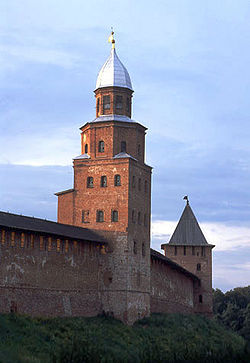
| |
| State Party | |
| Type | Cultural |
| Criteria | ii, iv, vi |
| Reference | 604 |
| Region** | European Russia |
| Inscription history | |
| Inscription | 1992 (16th Session) |
| * Name as inscribed on World Heritage List. ** Region as classified by UNESCO. | |
Geography
Ancient Novgorod rose to a political force partially due to its ideal location with easy access to both the Oka and the Volga Rivers. It is located in the northwest region of Russia, an area commonly referred to as Russia's heartland. The title of the area reflects the high agricultural productivity of the region, as well as the overall economic importance of the area to Russia as a whole.
Novgorod is situated between the major metropolises Moscow and Saint Petersburg, and is rising to become a population center in its own right. Recent estimates put the population at 216,856, which while lower than the measurements in Soviet Times, still represents a large city by Russian standards.
Economy
Education is an incredibly important part of the Novgorod culture, as it was one of the first cities in Russian history to build a schoolhouse large enough to hold three hundred students at once. The high levels of education in Novgorod directly spawned many of the key industries for the city, particularly the book-making and printing industries. Novgorod also expressed its intellectual history through art, becoming a major center for icon painting and applied decorative arts.
Currently, much of the Novgorod economy is funded through foreign investment sources. Novgorod is widely considered to be one of the most economically open Russian cities, a fact corroborated by tax breaks offered to foreign investors by the local government. Foreign investors tend to focus on heavy industry, particularly the radio-electronic, furniture, and chemical fields. The high levels of investment have had some effect on the local population, raising the living standard above many other urban centers in Russia. In particular, Novgorod has a smaller homeless population than Moscow or St. Petersburg.
History
Novgorod was among the first cities to be formed in ancient Russia. Due to its proximity to the rivers, a small civilization sprouted that connected the Greek markets to the Russian and Baltic markets. Archaeological evidence regarding the trade dates the city to the tenth century C.E., when Christianity first made its way into Russia.[2] Along with the ideas of Christianity, religious evangelists brought trade items to be traded in urban centers to fund their travels. While some records mention Novgorod as an urban center prior to the tenth century, it must be assumed that earlier accounts exaggerate the importance of the settlement, due to the lack of archaeological evidence to support a large city at an earlier time.
Princely state within Kievan Rus'
In 882, due to its growing economic and political authority, Oleg of Novgorod captured Kiev and founded the state of Kievan Rus. The city soon became the second most powerful city in Kievan Rus. It was ruled by a series of political organizations, called posadnicks, which governed when the ruler had no son to inherit the throne. When not being ruled by posadnicks, Novgorod had the good fortune to experience a series of benevolent rulers who governed with the best interest of the city's inhabitants in mind.
In Norse sagas the city is mentioned as the capital of Gardariki (i.e., the East Slavic lands). Four Viking kings—Olaf I of Norway, Olaf II of Norway, Magnus I of Norway, and Harald Haardraade—sought refuge in Novgorod from enemies at home. No more than a few decades after the death and subsequent canonization of Olaf II of Norway, in 1028, the city's community had erected a church in his memory, Saint Olaf's Church in Novgorod.
After the tenth century, Novgorod emerged as a strong political and religious center. Its secure position was primarily due to Novogorod's strong military onslaught against Constantinople. As a result of the military campaign, Novgorod maintained equal trading rights with Byzantine and began a cultural interchange. East Slavic tribes from Byzantine began pouring into the ancient Slavic state, influencing the art and culture of Novgorod.
The most notable among the benevolent leaders of Novgorod was Yaroslav I the Wise, who had sat as prince while his father, Vladimir the Great, was prince in Kiev. Yaroslav promulgated the first written code of laws (later incorporated into Russkaya Pravda) among the Eastern Slavs and is said to have granted the city a number of freedoms or privileges, which they often referred to in later centuries as precedents in their relations with other princes. His son, Vladimir, sponsored construction of the great St Sophia Cathedral, more accurately translated as The Cathedral of Holy Wisdom, which remains in modern times.
His Majesty Lord Novgorod the Great
Under a series of benevolent rulers, the inhabitants of Novgorod were steadily granted increased independence and political autonomy. As a result of their increased role in the political process, it soon became apparent to the inhabitants of Novgorod that a singular ruling authority was not necessary for Novgorod to function. As a result of this revelation, the Novgorodians dismissed their prince in 1136.
This date is seen as the traditional beginning of the Novgorod Republic, which invited and dismissed a series of princes over the next two centuries in order to rule Novgorod. While the veche, or electing authority, maintained supreme nominal power, some powerful leaders were able to assert a strong agenda over the objections of the people.[3]
The city state controlled most of Europe's northeast, from today's Estonia to the Ural Mountains, making it one of the largest states in medieval Europe, although much of the territory north and east of Lakes Lagoda and Onega were sparsely populated and never organized politically. While a basic outline of the various officials and the veche can be drawn up, the city-state's exact political constitution remains uncertain. The boyars and the archbishop ruled the city collectively, although where one officials power ended and another's began is uncertain. The prince, although reduced in power beginning in about the mid-twelfth century, was represented by his namestnik or lieutenant, and still played important roles as a military commander, legislator, and jurist. The exact composition of the veche, too, is uncertain, with some scholars such as Vasily Kliuchevksii claiming it was democratic in nature, while later scholars, such as Valentin Ianin and Alesandr Khoroshev, see it as a "sham democracy" controlled by the ruling elite.
Novgorod, with its unique political structure, soon became a thriving center for arts and culture. During the Medieval Ages Novgorod gained its reputation for literacy and education, a reputation that stayed with the city for most of its legacy.
Written records at this time are in the form of birch bark documents, many of which were written in the archbishop's scriptorium. It was in Novgorod that the oldest Slavic book written north of Macedonia and the oldest inscription in a Finnic language were unearthed. Possibly due to the intellectual and cultural strength of Novgorod, Novgorod did not fall during the Mongol invasion of ancient Russia. During this invasion, many surrounding cities fell to the Mongol invaders, but the cultural beacon of Novgorod resisted the invasion.
Within the united Russian state
Despite being able to resist the Mongol invaders, Novgorod began to falter politically in the early fifteenth century. Many scholars trace Novgorod's crumbling political power to an inability to provide the basic needs for its inhabitants. The citizens of Novgorod were particularly threatened by a lack of grain, which drove many citizens close to starvation. In order to rectify the lack of bread Novgorod made a political agreement with Moscow and Tver to provide much needed grain. These cities used the agreement to exercise political control over Novgorod, and the city's independence began to weaken in proportionate to its dependence on Moscow and Tver for grain. Novgorod was eventually annexed by Moscow in 1478.
Eventually Ivan III annexed the city to Muscovy in 1478. Novgorod remained the third largest Russian city, however, until the famine of 1560s and Ivan the Terrible sacking the city and slaughtering thousands of its inhabitants in 1570. The city's merchant elite and nobility were deported to Moscow, Yaroslavl, and elsewhere.
The difficulties for Novgorod continued in the Time of Trouble, when the city fell to Swedish troops. According to some accounts, the city voluntarily submitted to Swedish rule. Novgorod continued under Swedish authority for six years, after which time it was returned to Russia and allowed to rebuild a level of political authority. After the transfer of Novgorod to Russia, the city began an ambitious program of building and many of its most famous structures were constructed during this time period. Notable examples of this period of architecture include the Cathedral of the Sign and Vyazhischi Monastery. The most famous of Russian patriarchs, Nikon, occupied the metropolitan see of Novgorod between 1648 and 1652.
Novgorod became the administrative center of the Novgorod Governorate in 1727, demonstrating its reclaimed importance to Russia. This administrative division existed until 1927. Between 1927 and 1944 the city was a part of Leningrad Oblast, and then became an administrative center of the newly formed Novgorod Oblast.
Novgorod continued to be important to Russia until World War II, when German troops occupied the city and systematically destroyed many of the historical and cultural landmarks.
When the Red Army liberated the city on January 19, 1944, out of 2,536 stone buildings, fewer than forty were still standing. After the war, the downtown was gradually restored according to a plan worked out by Alexey Shchusev. Its chief monuments have been declared a World Heritage Site. In 1998, the city was officially renamed Veliky Novgorod, thus partly reverting to its medieval title "Lord Novgorod the Great."
Sights and Landmarks
No other Russian or Ukrainian city can compete with Novgorod in the variety and age of its medieval monuments. The foremost among these is the St Sophia Cathedral, built between 1045 and 1050 under the patronage of Vladimir Yaroslavich, the son of Yaroslav the Wise (Vladimir is buried in the cathedral along with his mother, Anna.)[4] The Cathedral is one of the most finely preserved examples of eleventh century Russian architecture. It is particularly noted for its Russian style architecture, sharply different from the French inspired architecture favored by previous Russian royal families. One of the most prominent features of the cathedral is its distinctive bronze gates, which were originally thought to have been made in Magdeburg during the twelfth century C.E., but have now found to been purchased late into the fifteenth century.[5] A distinctively different architectural style is apparent in the Saviour Cathedral of Kutyn Monastery, which is patterned after the cathedrals in Moscow. This church, along with other churches built during the fifteenth century, is patterned after Muscovite architectural trends.
The Novgorod Kremlin, traditionally known as the Detinets, also contains the oldest palace in Russia (the so-called Chamber of the Facets, 1433), which served as the main meeting hall of the archbishops; the oldest Russian bell tower (mid-fifteenth century), and the oldest Russian clock tower (1673). The Palace of Facets, the bell tower, and the clock tower were originally built on the orders of Archbishop Evfimii II, although the clock tower collapsed in the seventeenth century and had to be rebuilt and much of the palace of Evfimii II is no longer extant. Among later structures, the most remarkable are a royal palace (1771) and a bronze monument to the Millennium of Russia, representing the most important figures from the country's history (unveiled in 1862).
Novgorod's conquest by Ivan III in 1478 decisively changed the character of local architecture. Large commissions were thenceforth executed by Muscovite masters and patterned after cathedrals of Moscow Kremlin: e.g., the Saviour Cathedral of Khutyn Monastery (1515), the Cathedral of the Mother of God of the Sign (1688), and the St. Nicholas Cathedral of Vyaschizhy Monastery (1685). Nevertheless, the styles of some parochial churches were still in keeping with local traditions: e.g., the churches of Myrrh-bearing Women (1510) and of Sts Boris and Gleb (1586).
Notes
- ↑ Preliminary results of the 2010 All-Russian Population Census (in Russian) Retrieved February 9, 2012.
- ↑ V. L. (Valentin Lavrent’evich) Ianin and M. Kh. (Mark Khaimovich) Aleshkovskii, “Proskhozhdenie Novgoroda: (k postanovke problemy),” Istoriia SSSR 2, 1971, 32-61.
- ↑ Michael C. Paul, “The Iaroslavichi and the Novgorodian Veche 1230-1270: A Case Study on Princely Relations with the Veche,” Russian History/ Histoire Russe 31, No. 1-2, Spring-Summer 2004, 39-59.
- ↑ Tatiana Tsarevskaia, St. Sophia's Cathedral in Novgorod (Moscow: Severnyi Palomnik, 2005), 3.
- ↑ Irena Daniec Jadwiga, The Message of Faith and Symbol in European Medieval Bronze Church Doors (Danbury, CT: Rutledge Books, 1999), Chapter III "An Enigma: The Medieval Bronze Church Door of Płock in the Cathedral of Novgorod," 67-97; Mikhail Tsapenko, ed., Early Russian Architecture (Moscow: Progress Publisher, 1969), 34-38.
ReferencesISBN links support NWE through referral fees
- Costantino, Maria. 2001. The Illustrated Flag Handbook. New York: Gramercy Books. ISBN 0-517-21810-0
- DK Publishing. Great Britain (Eyewitness Guide). New York: DK Publishing. ISBN 0756615429
- Lewis, Brenda Ralph. 2002. Great Civilizations. Bath: Paragon Publishing. ISBN 0-75256-141-3
External links
All links retrieved May 3, 2023.
Credits
New World Encyclopedia writers and editors rewrote and completed the Wikipedia article in accordance with New World Encyclopedia standards. This article abides by terms of the Creative Commons CC-by-sa 3.0 License (CC-by-sa), which may be used and disseminated with proper attribution. Credit is due under the terms of this license that can reference both the New World Encyclopedia contributors and the selfless volunteer contributors of the Wikimedia Foundation. To cite this article click here for a list of acceptable citing formats.The history of earlier contributions by wikipedians is accessible to researchers here:
The history of this article since it was imported to New World Encyclopedia:
Note: Some restrictions may apply to use of individual images which are separately licensed.
